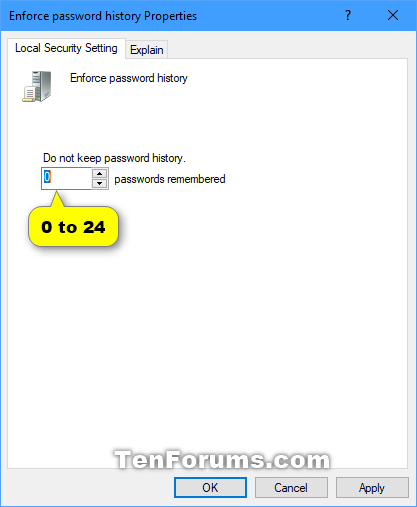How to Enforce Password History for Local Accounts in Windows 10
Information
The Enforce password history policy setting determines the number of unique new passwords that must be associated with a local account before an old password can be reused. Password reuse is an important concern in any organization. Many users want to reuse the same password for their account over a long period of time. The longer the same password is used for a particular account, the greater the chance that an attacker will be able to determine the password through brute force attacks. If users are required to change their password, but they can reuse an old password, the effectiveness of a good password policy is greatly reduced.
Specifying a low number for Enforce password history allows users to continually use the same small number of passwords repeatedly. If you do not also set Minimum password age, users can change their password as many times in a row as necessary to reuse their original password.
This tutorial will show you how to enforce password history to make local accounts use a specified number of new passwords before an old password can be reused in Windows 10.
You must be signed in as an administrator to change the minimum password length.
CONTENTS:
- Option One: To Change Enforce Password History Settings for Local Accounts using Local Security Policy
- Option Two: To Change Enforce Password History Settings for Local Accounts using Command Prompt
EXAMPLE: "The password you entered doesn't meet password policy requirements" error
Note
Local Security Policy is only available in the Windows 10 Pro, Enterprise, and Education editions.
All editions can use Option Two below.
1. Press the Win+R keys to open Run, type secpol.msc into Run, and click/tap on OK to open Local Security Policy.
2. Navigate to Account Policies and Password Policy in the left pane of Local Security Policy. (see screenshot below)
3. In the right pane of Password Policy, double click/tap on the Enforce password history policy. (see screenshot above)
4. Type in a number between 0 and 24 for how many passwords you want remembered, and click/tap on OK. (see screenshots below)
Note
The default setting is 0 passwords remembered to not enforce password history for local accounts.

5. When finished, you can close the Local Security Policy window if you like.
6. If you like, you may also want to change the minimum password age to a higher number to help prevent local accounts from just changing their password as many times in a row as necessary to reuse their original password.
1. Open an elevated command prompt.
2. Enter the command below into the elevated command prompt, press Enter, and make note of the current length (number) of password history maintained (remembered). (see screenshot below)

net accounts
3. Enter the command below into the elevated command prompt, and press Enter. (see screenshot below)

net accounts /uniquepw:Number
Note
Substitute Number in the command above with a number between 0 (none) and 24 for how many passwords you want remembered.
The default setting is 0 passwords remembered to not enforce password history for local accounts.
4. When finished, you can close the elevated command prompt if you like.
5. If you like, you may also want to change the minimum password age to a higher number to help prevent local accounts from just changing their password as many times in a row as necessary to reuse their original password.
That's it,
Shawn
Related Tutorials
- How to Enable or Disable Password Expiration for Local Accounts in Windows 10
- How to Add Password to Local Account in Windows 10
- How to Allow or Prevent User to Change Password in Windows 10
- How to Change Password of Local Account or Microsoft Account in Windows 10
- How to Change Maximum and Minimum Password Age for Local Accounts in Windows 10
- How to Change Minimum Password Length for Local Accounts in Windows 10
- How to Force Local Account to Change Password at Next Sign-in in Windows 10
- How to Reset Password of Local Account or Microsoft Account in Windows 10
- How to Remove Password of Local Account in Windows 10
- How to Change Account Lockout Threshold for Local Accounts in Windows 10
- How to Change Account Lockout Duration for Local Accounts in Windows 10
- How to Change Reset Account Lockout Counter for Local Accounts in Windows 10
- How to Remove Change a Password from Ctrl+Alt+Del Screen in Windows
Enforce Password History for Local Accounts in Windows 10

Enforce Password History for Local Accounts in Windows 10
How to Enforce Password History for Local Accounts in Windows 10Published by Shawn BrinkCategory: User Accounts
25 Apr 2021
Tutorial Categories


Related Discussions







